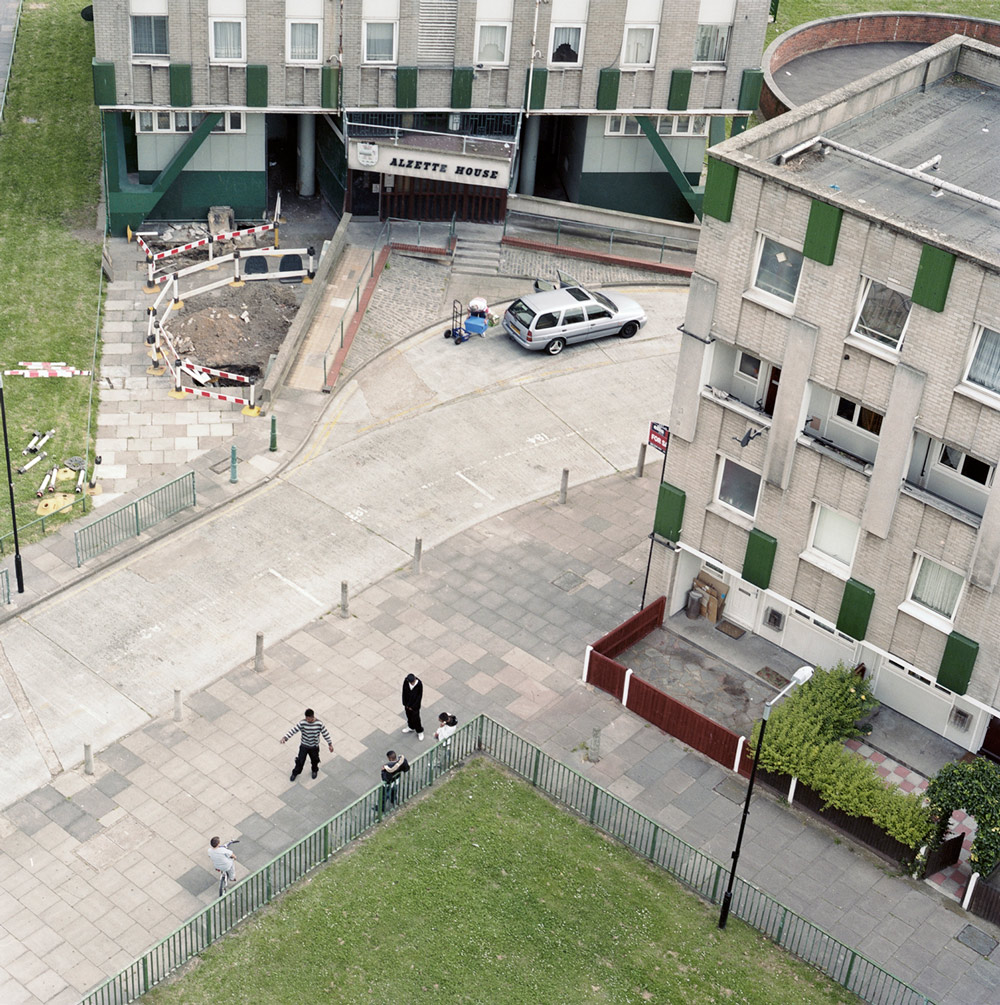-

Shared spaces of British modernism
by Rob Wilson

Park Hill Housing Project, c.1962 (Video: Yorkshire Film Archive, source: Open University)
Alison and Peter Smithson: an early collage study for the future Robin Hood Gardens.
"Social housing, Manisty Street, London", ink drawing, 1963.
(Image: © Centre Pompidou, MNAM-CCI, Dist. RMN-Grand Palais / Jean-Claude) -
With informal initiatives taking advantage of the generous common spaces designed into Britain's modernist housing estates, Rob Wilson wonders if the failed ambitions of post-war architects could yet be realised.
The history of the Heygate Estate in South London has followed a similar arc to many other modernist council estates. Designed by Tim Tinker and completed in 1974, it provided modern homes for 3,000 people, many moving from slum conditions. Yet over the years Heygate became a near-slum itself, housing a near ghetto-ised community living in fear of gang violence. Today, the estate is being demolished, its site redeveloped with over 2,500 new homes, less than five percent of them social housing. So far, so depressingly familiar.
Yet over the last few years Heygate’s leafy communal spaces, unofficially renamed the “Elephant and Castle Urban Forest”, underwent an interesting transformation. Gardening cooperatives divvied up plots under its concrete bastions, previously neglected corners were used for parcour classes, and in one block an organisation called Hotel Elephant offered gallery and studio space, as well as community educational projects.
Of course this has all happened in the shadow of the bulldozer, after many residents had already moved out. But this new usage of the shared spaces and built-in shop units typical of a modernist estate shows how the architecture can actually assist in social cohesion and cannot always be blamed as the primary cause for the sense of alienation and consequent social breakdown common in such estates. This failure was as much about a lack of community agency, often numbed by the nannying and opaque bureaucracy of the welfare state and the councils that ran the blocks.
Whilst the current faux-nostalgia for a failed utopia of modernism will pass, many of these estates were in fact serious attempts to benefit their residents by incorporating the common ground of the city into the architecture itself.
-
Park Hill in Sheffield (1957-61) by Jack Lynn and Ivor Smith was the most complete application of the Smithson’s “streets in the air idea”; neighbours were rehoused next to each other and extensive facilities including shops, a school and four pubs were built into the estate. Another innovative model was the “vertical street” proposed by Denys Lasdun in his design for Keeling House in Bethnal Green, London, a so-called “butterfly block” arrangement with four stacked wings of flats arranged around a communal threshold and services core.

The Cranbrook Estate in Bethnal Green, East London, was designed by Francis Skinner, Douglas Bailey and Berthold Lubetkin in 1963. (Photo: Steven Day, “Cranbrook Estate, Mace Street”, 2008, chromogenic print, 71.12 x 71.12 cm, edition of five.)
The most famous, copied (and later vilified) design elements exemplifying this were “streets in the air”, first proposed by Alison and Peter Smithson for their unbuilt Golden Lane project in London from 1952: access decks free from road traffic, wide enough for milk-carts to deliver the daily pint and where “the refuse chute takes the place of the village pump” – as Peter Smithson claimed. Though it was perhaps arrogant to believe that the full complexity of street life could be incorporated within architecture, the Smithson’s projects demonstrate how the design focus in modernist British social housing schemes was always on collectively used spaces rather than, say, the ratio of bedrooms to bathrooms, as it often is today.
-
In such schemes and others, shifting housing policies, maintenance issues, and often plain bad design, ultimately ate away at the sense of community that the architecture was meant to forge. By the time the Smithsons finally got the chance to build housing at scale at Robin Hood Gardens in the late 1960s, even they were ambivalent about their design, saying: “we may be asking people to live in a way that is stupid”.
Like the Heygate Estate, Robin Hood Gardens is now due for imminent demolition, its 213 flats will be replaced by 700 units, with a consequent loss of shared open space. Lasdun’s Keeling House has long since been converted into a private block, a new glass entrance lobby cutting across any subtleties of gradation in its public to private thresholds. Communal space is being reduced and privatised – becoming a security buffer zone to pass through rather than spend time in, no longer acting as effective mediation to the wider space of the city. Control by the Big-Brother State has been replaced by new off-site hierarchies of control: management companies and non-elected registered social landlords.
So it is models such as the Heygate Estate, showing how self-organisation can feed back into a fuller occupation of architectural shared spaces – demanding more of residents, yet giving them back more – that could finally see the fulfillment of the potential of those 1960s estates, if they escape demolition. With a shift in the sense of agency, and a re-imagining of their common parts, they could begin not just to mimic the community of the traditional street, but allow for an innovative shared renegotiation of their “concrete commons”. p
Alison and Peter Smithson, “Grand Ensemble of Golden Lane, London, Deck Perspective”,
photomontage with Marylin Monroe, Jo Di Maggio, Peter Ustinov etc., 1952.
(Image: © Centre Pompidou, MNAM-CCI, Dist. RMN-Grand Palais / Jean-Claude)
-
Search
-
FIND PRODUCTS
PRODUCT GROUP
- Building Materials
- Building Panels
- Building technology
- Façade
- Fittings
- Heating, Cooling, Ventilation
- Interior
- Roof
- Sanitary facilities
MANUFACTURER
- 3A Composites
- Alape
- Armstrong
- Caparol
- Eternit
- FSB
- Gira
- Hagemeister
- JUNG
- Kaldewei
- Lamberts
- Leicht
- Solarlux
- Steininger Designers
- Stiebel Eltron
- Velux
- Warema
- Wilkhahn
-
Follow Us
Tumblr
New and existing Tumblr users can connect with uncube and share our visual diary.
»Architecture starts when you carefully put two bricks together. There it begins.«
Ludwig Mies van der Rohe
Keyboard Shortcuts
- Supermenu
- Skip Articles
- Turn Pages
- Contents


